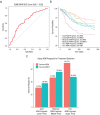The development and internal evaluation of a predictive model to identify for whom Mindfulness-Based Cognitive Therapy (MBCT) offers superior relapse prevention for recurrent depression versus maintenance antidepressant medication
- PMID: 36698442
- PMCID: PMC7614103
- DOI: 10.1177/21677026221076832
The development and internal evaluation of a predictive model to identify for whom Mindfulness-Based Cognitive Therapy (MBCT) offers superior relapse prevention for recurrent depression versus maintenance antidepressant medication
Abstract
Depression is highly recurrent, even following successful pharmacological and/or psychological intervention. We aimed to develop clinical prediction models to inform adults with recurrent depression choosing between antidepressant medication (ADM) maintenance or switching to Mindfulness-Based Cognitive Therapy (MBCT). Using data from the PREVENT trial (N=424), we constructed prognostic models using elastic net regression that combined demographic, clinical and psychological factors to predict relapse at 24 months under ADM or MBCT. Only the ADM model (discrimination performance: AUC=.68) predicted relapse better than baseline depression severity (AUC=.54; one-tailed DeLong's test: z=2.8, p=.003). Individuals with the poorest ADM prognoses who switched to MBCT had better outcomes compared to those who maintained ADM (48% vs. 70% relapse, respectively; superior survival times [z=-2.7, p=.008]). For individuals with moderate-to-good ADM prognosis, both treatments resulted in similar likelihood of relapse. If replicated, the results suggest that predictive modeling can inform clinical decision-making around relapse prevention in recurrent depression.
Conflict of interest statement
The author(s) declared that there were no conflicts of interest with respect to the authorship or the publication of this article.
Figures


Similar articles
-
The effectiveness and cost-effectiveness of mindfulness-based cognitive therapy compared with maintenance antidepressant treatment in the prevention of depressive relapse/recurrence: results of a randomised controlled trial (the PREVENT study).Health Technol Assess. 2015 Sep;19(73):1-124. doi: 10.3310/hta19730. Health Technol Assess. 2015. PMID: 26379122 Free PMC article. Clinical Trial.
-
Examining what works for whom and how in mindfulness-based cognitive therapy (MBCT) for recurrent depression: moderated-mediation analysis in the PREVENT trial.Br J Psychiatry. 2025 Apr;226(4):213-221. doi: 10.1192/bjp.2024.178. Epub 2024 Nov 8. Br J Psychiatry. 2025. PMID: 39512158 Free PMC article. Clinical Trial.
-
Update to the study protocol for a randomized controlled trial comparing mindfulness-based cognitive therapy with maintenance anti-depressant treatment depressive relapse/recurrence: the PREVENT trial.Trials. 2014 Jun 10;15:217. doi: 10.1186/1745-6215-15-217. Trials. 2014. PMID: 24916319 Free PMC article. Clinical Trial.
-
Comparative effectiveness of continuation and maintenance treatments for persistent depressive disorder in adults.Cochrane Database Syst Rev. 2019 May 20;5(5):CD012855. doi: 10.1002/14651858.CD012855.pub2. Cochrane Database Syst Rev. 2019. PMID: 31106850 Free PMC article.
-
Approaches for discontinuation versus continuation of long-term antidepressant use for depressive and anxiety disorders in adults.Cochrane Database Syst Rev. 2021 Apr 15;4(4):CD013495. doi: 10.1002/14651858.CD013495.pub2. Cochrane Database Syst Rev. 2021. PMID: 33886130 Free PMC article.
Cited by
-
Developing an individualized treatment rule for Veterans with major depressive disorder using electronic health records.Mol Psychiatry. 2024 Aug;29(8):2335-2345. doi: 10.1038/s41380-024-02500-0. Epub 2024 Mar 14. Mol Psychiatry. 2024. PMID: 38486050 Free PMC article.
-
Mindfulness-Based Cognitive Therapy in Clinical Practice: A Systematic Review of Neurocognitive Outcomes and Applications for Mental Health and Well-Being.J Clin Med. 2025 Mar 3;14(5):1703. doi: 10.3390/jcm14051703. J Clin Med. 2025. PMID: 40095733 Free PMC article. Review.
-
Initial evaluation of a personalized advantage index to determine which individuals may benefit from mindfulness-based cognitive therapy for suicide prevention.Behav Res Ther. 2024 Dec;183:104637. doi: 10.1016/j.brat.2024.104637. Epub 2024 Sep 18. Behav Res Ther. 2024. PMID: 39306938 Clinical Trial.
-
A common factors perspective on mindfulness-based interventions.Nat Rev Psychol. 2022 Oct;1(10):605-619. doi: 10.1038/s44159-022-00090-8. Epub 2022 Aug 1. Nat Rev Psychol. 2022. PMID: 36339348 Free PMC article.
-
Components of Behavioral Activation Therapy for Depression Engage Specific Reinforcement Learning Mechanisms in a Pilot Study.Comput Psychiatr. 2022 Oct 13;6(1):238-255. doi: 10.5334/cpsy.81. eCollection 2022. Comput Psychiatr. 2022. PMID: 38774780 Free PMC article.
References
-
- Barnard P. J., Watkins E. R., Mackintosh B., Nimmo-Smith I. (2007, September 12–14). Getting stuck in a mental rut: Some process and experiential attributes [Conference session]. 35th Congress of the British Association for Behavioural and Cognitive Psychotherapies, Brighton, England.
-
- Beck A. T., Steer R. A., Brown G. K. (1996). Manual for the Beck Depression Inventory-II. Psychological Cooperation.
Grants and funding
LinkOut - more resources
Full Text Sources
